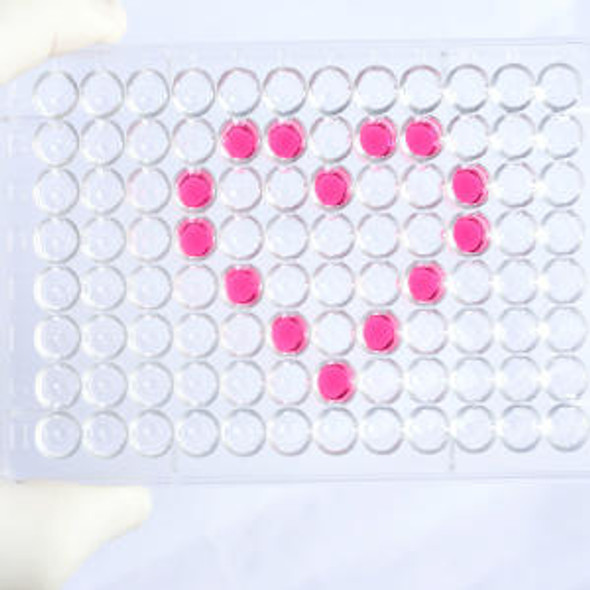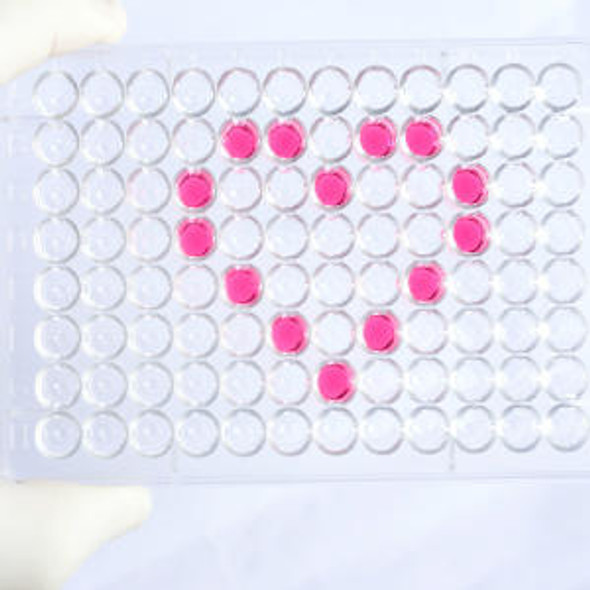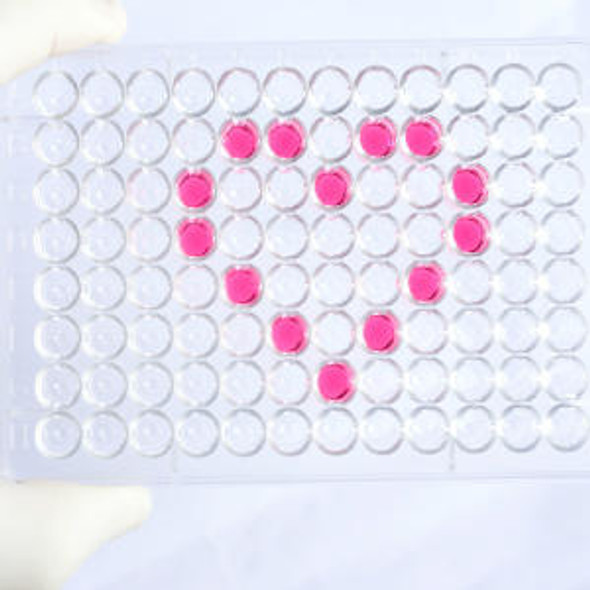Human TNFAIP3 / TNF alpha-induced protein 3 ELISA Kit
- SKU:
- HUFI02161
- Product Type:
- ELISA Kit
- Size:
- 96 Assays
- Uniprot:
- P21580
- Sensitivity:
- 0.188ng/ml
- Range:
- 0.313-20ng/ml
- ELISA Type:
- Sandwich ELISA, Double Antibody
- Synonyms:
- TNFAIP3, OTUD7C, TNFA1P2, A20TNFA1P2, EC 3.4.19.12, EC 6.3.2.-, OTU domain-containing protein 7C, Putative DNA-binding protein A20, TNF alpha-induced protein 3, tumor necrosis factor alpha-induced protein 3, tumor necrosis factor inducible protein A2
- Reactivity:
- Human
Description
| Product Name: | Human TNFAIP3 / TNF alpha-induced protein 3 ELISA Kit |
| Product Code: | HUFI02161 |
| Size: | 96 Assays |
| Alias: | TNFAIP3, OTUD7C, TNFA1P2, A20TNFA1P2, EC 3.4.19.12, EC 6.3.2.-, OTU domain-containing protein 7C, Putative DNA-binding protein A20, TNF alpha-induced protein 3, tumor necrosis factor alpha-induced protein 3, tumor necrosis factor inducible protein A20, tumor necrosis factor, alpha-induced protein 3, Zinc finger protein A20 |
| Detection method: | Sandwich ELISA, Double Antibody |
| Application: | This immunoassay kit allows for the in vitro quantitative determination of Human TNFAIP3 concentrations in serum plasma and other biological fluids. |
| Sensitivity: | 0.188ng/ml |
| Range: | 0.313-20ng/ml |
| Storage: | 4°C for 6 months |
| Note: | For Research Use Only |
| Recovery: | Matrices listed below were spiked with certain level of Human TNFAIP3 and the recovery rates were calculated by comparing the measured value to the expected amount of Human TNFAIP3 in samples. | ||||||||||||||||
| |||||||||||||||||
| Linearity: | The linearity of the kit was assayed by testing samples spiked with appropriate concentration of Human TNFAIP3 and their serial dilutions. The results were demonstrated by the percentage of calculated concentration to the expected. | ||||||||||||||||
| |||||||||||||||||
| CV(%): | Intra-Assay: CV<8% Inter-Assay: CV<10% |
| Component | Quantity | Storage |
| ELISA Microplate (Dismountable) | 8×12 strips | 4°C for 6 months |
| Lyophilized Standard | 2 | 4°C/-20°C |
| Sample/Standard Dilution Buffer | 20ml | 4°C |
| Biotin-labeled Antibody(Concentrated) | 120ul | 4°C (Protect from light) |
| Antibody Dilution Buffer | 10ml | 4°C |
| HRP-Streptavidin Conjugate(SABC) | 120ul | 4°C (Protect from light) |
| SABC Dilution Buffer | 10ml | 4°C |
| TMB Substrate | 10ml | 4°C (Protect from light) |
| Stop Solution | 10ml | 4°C |
| Wash Buffer(25X) | 30ml | 4°C |
| Plate Sealer | 5 | - |
Other materials and equipment required:
- Microplate reader with 450 nm wavelength filter
- Multichannel Pipette, Pipette, microcentrifuge tubes and disposable pipette tips
- Incubator
- Deionized or distilled water
- Absorbent paper
- Buffer resevoir
| Uniprot | P21580 |
| UniProt Protein Function: | TNFAIP3: Ubiquitin-editing enzyme that contains both ubiquitin ligase and deubiquitinase activities. Involved in immune and inflammatory responses signaled by cytokines, such as TNF-alpha and IL-1 beta, or pathogens via Toll-like receptors (TLRs) through terminating NF-kappa-B activity. Essential component of a ubiquitin-editing protein complex, comprising also RNF11, ITCH and TAX1BP1, that ensures the transient nature of inflammatory signaling pathways. In cooperation with TAX1BP1 promotes disassembly of E2-E3 ubiquitin protein ligase complexes in IL-1R and TNFR-1 pathways; affected are at least E3 ligases TRAF6, TRAF2 and BIRC2, and E2 ubiquitin-conjugating enzymes UBE2N and UBE2D3. In cooperation with TAX1BP1 promotes ubiquitination of UBE2N and proteasomal degradation of UBE2N and UBE2D3. Upon TNF stimulation, deubiquitinates 'Lys-63'-polyubiquitin chains on RIPK1 and catalyzes the formation of 'Lys-48'-polyubiquitin chains. This leads to RIPK1 proteasomal degradation and consequently termination of the TNF- or LPS-mediated activation of NF-kappa-B. Deubiquinates TRAF6 probably acting on 'Lys-63'-linked polyubiquitin. Upon T-cell receptor (TCR)-mediated T-cell activation, deubiquitinates 'Lys-63'-polyubiquitin chains on MALT1 thereby mediating disassociation of the CBM (CARD11:BCL10:MALT1) and IKK complexes and preventing sustained IKK activation. Deubiquinates NEMO/IKBKG; the function is facilitated by TNIP1 and leads to inhibition of NF-kappa-B activation. Upon stimulation by bacterial peptidoglycans, probably deubiquitinates RIPK2. Can also inhibit I-kappa-B-kinase (IKK) through a non-catalytic mechanism which involves polyubiquitin; polyubiquitin promotes association with IKBKG and prevents IKK MAP3K7-mediated phosphorylation. Targets TRAF2 for lysosomal degradation. In vitro able to deubiquitinate both 'Lys-48'- and 'Lys-63' polyubiquitin chains. Inhibitor of programmed cell death. Has a role in the function of the lymphoid system. Homodimer. Interacts with TNIP1, TAX1BP1 and TRAF2. Interacts with RNF11, ITCH and TAX1BP1 only after TNF stimulation; these interaction are transient and they are lost after 1 hour of stimulation with TNF. Interacts with YWHAZ and YWHAH. Interacts with IKBKG; the interaction is induced by TNF stimulation and by polyubiquitin. Interacts with RIPK1. Interacts with UBE2N; the interaction requires TAX1BP1. Interacts with TRAF6; the interaction is inhibited by HTLV-1 protein Tax. By TNF. Belongs to the peptidase C64 family. |
| UniProt Protein Details: | Protein type:EC 3.4.19.12; Ubiquitin conjugating system; Apoptosis; Protease Chromosomal Location of Human Ortholog: 6q23 Cellular Component: centrosome; lysosome; cytoplasm; nucleus; cytosol Molecular Function:protein binding; ubiquitin binding; DNA binding; protease binding; protein self-association; zinc ion binding; ubiquitin-specific protease activity; ubiquitin-protein ligase activity; kinase binding; ligase activity Biological Process: negative regulation of toll-like receptor 5 signaling pathway; negative regulation of smooth muscle cell proliferation; apoptosis; proteolysis; negative regulation of toll-like receptor 3 signaling pathway; negative regulation of interleukin-2 production; negative regulation of innate immune response; response to molecule of bacterial origin; negative regulation of interleukin-6 production; negative regulation of bone resorption; inflammatory response; negative regulation of chronic inflammatory response; protein deubiquitination; negative regulation of toll-like receptor 2 signaling pathway; B-1 B cell homeostasis; negative regulation of cyclin-dependent protein kinase activity; negative regulation of B cell activation; negative regulation of I-kappaB kinase/NF-kappaB cascade; negative regulation of tumor necrosis factor production; negative regulation of interleukin-1 beta production; protein oligomerization; regulation of germinal center formation; response to muramyl dipeptide; inhibition of NF-kappaB transcription factor; negative regulation of inflammatory response; negative regulation of toll-like receptor 4 signaling pathway; positive regulation of protein catabolic process; innate immune response; negative regulation of protein ubiquitination; regulation of defense response to virus by host; negative regulation of interferon type I production |
| NCBI Summary: | This gene was identified as a gene whose expression is rapidly induced by the tumor necrosis factor (TNF). The protein encoded by this gene is a zinc finger protein and ubiqitin-editing enzyme, and has been shown to inhibit NF-kappa B activation as well as TNF-mediated apoptosis. The encoded protein, which has both ubiquitin ligase and deubiquitinase activities, is involved in the cytokine-mediated immune and inflammatory responses. Several transcript variants encoding the same protein have been found for this gene. [provided by RefSeq, Jul 2012] |
| UniProt Code: | P21580 |
| NCBI GenInfo Identifier: | 112894 |
| NCBI Gene ID: | 7128 |
| NCBI Accession: | P21580.1 |
| UniProt Secondary Accession: | P21580,Q2HIX9, Q5VXQ7, Q9NSR6, B2R767, E1P588, |
| UniProt Related Accession: | P21580 |
| Molecular Weight: | 790 |
| NCBI Full Name: | Tumor necrosis factor alpha-induced protein 3 |
| NCBI Synonym Full Names: | tumor necrosis factor, alpha-induced protein 3 |
| NCBI Official Symbol: | TNFAIP3 |
| NCBI Official Synonym Symbols: | A20; OTUD7C; TNFA1P2 |
| NCBI Protein Information: | tumor necrosis factor alpha-induced protein 3; zinc finger protein A20; TNF alpha-induced protein 3; OTU domain-containing protein 7C; putative DNA-binding protein A20; tumor necrosis factor inducible protein A20 |
| UniProt Protein Name: | Tumor necrosis factor alpha-induced protein 3 |
| UniProt Synonym Protein Names: | OTU domain-containing protein 7C; Putative DNA-binding protein A20; Zinc finger protein A20Cleaved into the following 2 chains:A20p50; A20p37 |
| Protein Family: | TNFAIP3-interacting protein |
| UniProt Gene Name: | TNFAIP3 |
| UniProt Entry Name: | TNAP3_HUMAN |
*Note: Protocols are specific to each batch/lot. For the correct instructions please follow the protocol included in your kit.
Before adding to wells, equilibrate the SABC working solution and TMB substrate for at least 30 min at 37°C. When diluting samples and reagents, they must be mixed completely and evenly. It is recommended to plot a standard curve for each test.
| Step | Protocol |
| 1. | Set standard, test sample and control (zero) wells on the pre-coated plate respectively, and then, record their positions. It is recommended to measure each standard and sample in duplicate. Wash plate 2 times before adding standard, sample and control (zero) wells! |
| 2. | Aliquot 0.1ml standard solutions into the standard wells. |
| 3. | Add 0.1 ml of Sample / Standard dilution buffer into the control (zero) well. |
| 4. | Add 0.1 ml of properly diluted sample ( Human serum, plasma, tissue homogenates and other biological fluids.) into test sample wells. |
| 5. | Seal the plate with a cover and incubate at 37 °C for 90 min. |
| 6. | Remove the cover and discard the plate content, clap the plate on the absorbent filter papers or other absorbent material. Do NOT let the wells completely dry at any time. Wash plate X2. |
| 7. | Add 0.1 ml of Biotin- detection antibody working solution into the above wells (standard, test sample & zero wells). Add the solution at the bottom of each well without touching the side wall. |
| 8. | Seal the plate with a cover and incubate at 37°C for 60 min. |
| 9. | Remove the cover, and wash plate 3 times with Wash buffer. Let wash buffer rest in wells for 1 min between each wash. |
| 10. | Add 0.1 ml of SABC working solution into each well, cover the plate and incubate at 37°C for 30 min. |
| 11. | Remove the cover and wash plate 5 times with Wash buffer, and each time let the wash buffer stay in the wells for 1-2 min. |
| 12. | Add 90 µl of TMB substrate into each well, cover the plate and incubate at 37°C in dark within 10-20 min. (Note: This incubation time is for reference use only, the optimal time should be determined by end user.) And the shades of blue can be seen in the first 3-4 wells (with most concentrated standard solutions), the other wells show no obvious color. |
| 13. | Add 50 µl of Stop solution into each well and mix thoroughly. The color changes into yellow immediately. |
| 14. | Read the O.D. absorbance at 450 nm in a microplate reader immediately after adding the stop solution. |
When carrying out an ELISA assay it is important to prepare your samples in order to achieve the best possible results. Below we have a list of procedures for the preparation of samples for different sample types.
| Sample Type | Protocol |
| Serum | If using serum separator tubes, allow samples to clot for 30 minutes at room temperature. Centrifuge for 10 minutes at 1,000x g. Collect the serum fraction and assay promptly or aliquot and store the samples at -80°C. Avoid multiple freeze-thaw cycles. If serum separator tubes are not being used, allow samples to clot overnight at 2-8°C. Centrifuge for 10 minutes at 1,000x g. Remove serum and assay promptly or aliquot and store the samples at -80°C. Avoid multiple freeze-thaw cycles. |
| Plasma | Collect plasma using EDTA or heparin as an anticoagulant. Centrifuge samples at 4°C for 15 mins at 1000 × g within 30 mins of collection. Collect the plasma fraction and assay promptly or aliquot and store the samples at -80°C. Avoid multiple freeze-thaw cycles. Note: Over haemolysed samples are not suitable for use with this kit. |
| Urine & Cerebrospinal Fluid | Collect the urine (mid-stream) in a sterile container, centrifuge for 20 mins at 2000-3000 rpm. Remove supernatant and assay immediately. If any precipitation is detected, repeat the centrifugation step. A similar protocol can be used for cerebrospinal fluid. |
| Cell culture supernatant | Collect the cell culture media by pipette, followed by centrifugation at 4°C for 20 mins at 1500 rpm. Collect the clear supernatant and assay immediately. |
| Cell lysates | Solubilize cells in lysis buffer and allow to sit on ice for 30 minutes. Centrifuge tubes at 14,000 x g for 5 minutes to remove insoluble material. Aliquot the supernatant into a new tube and discard the remaining whole cell extract. Quantify total protein concentration using a total protein assay. Assay immediately or aliquot and store at ≤ -20 °C. |
| Tissue homogenates | The preparation of tissue homogenates will vary depending upon tissue type. Rinse tissue with 1X PBS to remove excess blood & homogenize in 20ml of 1X PBS (including protease inhibitors) and store overnight at ≤ -20°C. Two freeze-thaw cycles are required to break the cell membranes. To further disrupt the cell membranes you can sonicate the samples. Centrifuge homogenates for 5 mins at 5000xg. Remove the supernatant and assay immediately or aliquot and store at -20°C or -80°C. |
| Tissue lysates | Rinse tissue with PBS, cut into 1-2 mm pieces, and homogenize with a tissue homogenizer in PBS. Add an equal volume of RIPA buffer containing protease inhibitors and lyse tissues at room temperature for 30 minutes with gentle agitation. Centrifuge to remove debris. Quantify total protein concentration using a total protein assay. Assay immediately or aliquot and store at ≤ -20 °C. |
| Breast Milk | Collect milk samples and centrifuge at 10,000 x g for 60 min at 4°C. Aliquot the supernatant and assay. For long term use, store samples at -80°C. Minimize freeze/thaw cycles. |










